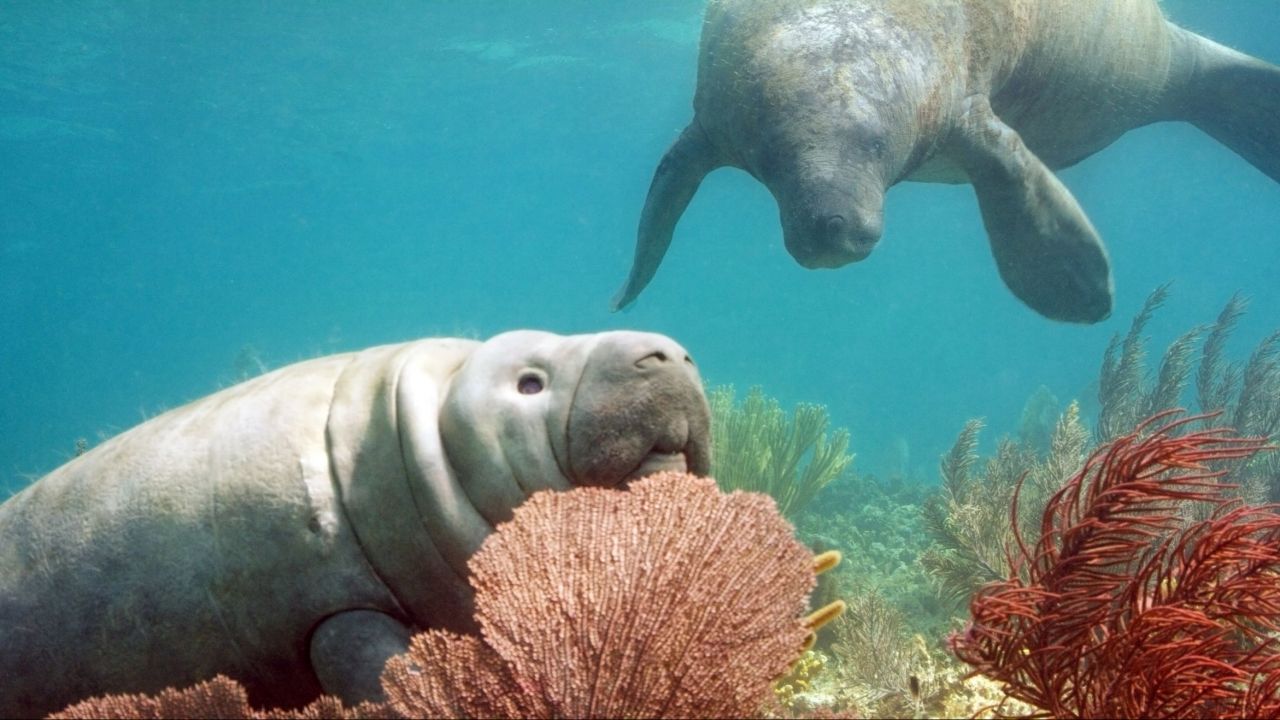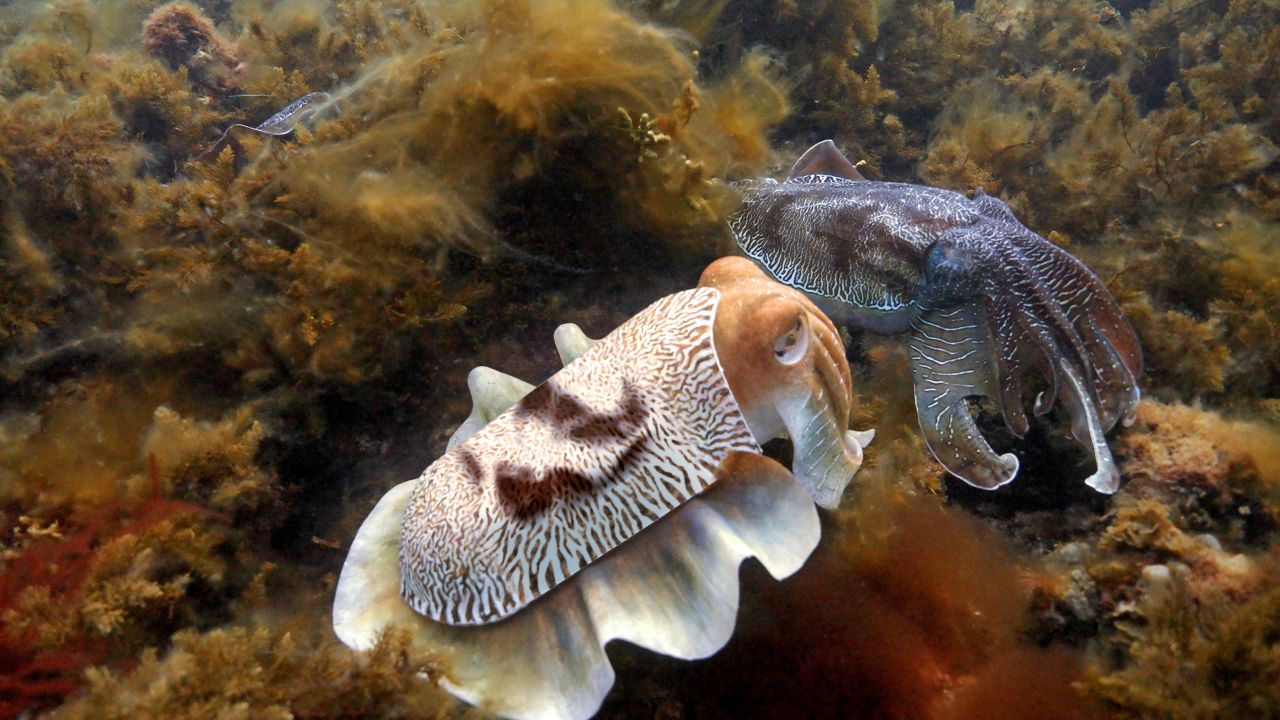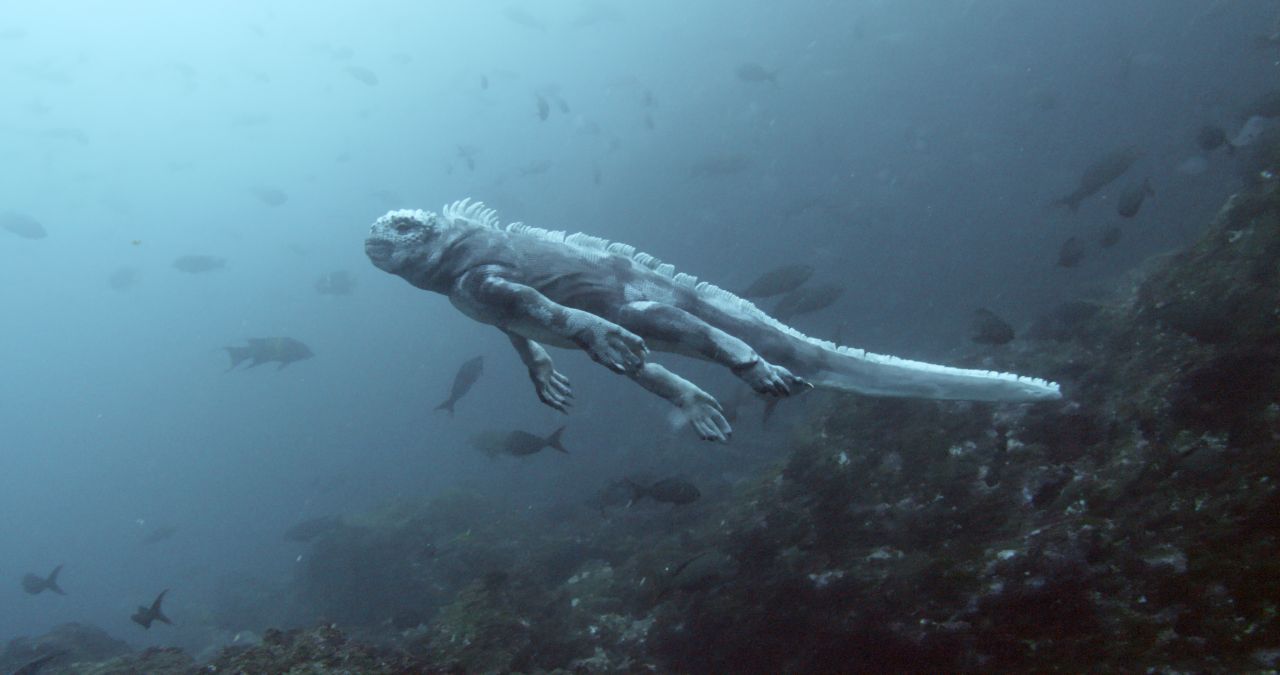
Spy Coconut Octopus facing camera. Credit: Ben McCulloch Trayner / © John Downer Productions
New animatronic spy creatures explore the seas and capture never-before-seen animal behavior in NATURE’s four-part series Spy in the Ocean. The Spies include a whale calf (the biggest one yet!), shark, dolphin, manatee, cuttlefish, octopus, seal, crab and many more. Utilizing the latest subsea technology, these robot lookalikes ventured to the depths of the ocean floor to interact with their animal counterparts, communicating with them and mimicking their patterns.
Series Producers Matthew Gordon and Huw Williams, as well as Executive Producer Philip Dalton, answered viewers’ questions about the series in a Reddit AMA on Wednesday, November 8.
Spy in the Ocean is currently airing on PBS on Wednesdays at 8/7c (check local listings). You can watch the first three episodes now at pbs.org, YouTube, or on the PBS App.

Manatee meeting Spy manatee on seabed in Belize. Credit: Steve Downer / © John Downer Productions
Have your spies ever been attacked?
(Huw Williams) We always set out to design our Spy creatures to avoid being attacked and to be as passive as possible. We do this in a number of different ways. Firstly we will often make them look like a female version of the animal we are setting out to film. The other method is to make them look like juveniles so that there are no large dominant males thinking he has a new contender. That’s not to say it all goes particularly well for our spies. Spy pelican had a major malfunction in this series, crashing into the surf below. The poor modelmaker had to be up all night bringing it back to life. Spy rockhopper penguin brought out the jealous side of a female rockhopper who thought our spy was getting a bit over-friendly with her mate. She ended up ripping our spy’s head off which wasn’t ideal. But generally, we have very few acts of violence towards our spies because we try to design them to avoid any trouble.
What was the most unusual creature your robots encountered?
(Huw Williams) For me, it has to be the cephalopods. they have this otherworldly character, which is just fascinating to behold. It feels like there is so much more to learn from these unique, intelligent creatures. Watching as the mimic octopus does a very convincing job of looking like the other animals of the ocean. Even copying our spy! You can’t help but watch with open mouths. Spending time with the cuttlefish was a delight. There were hundreds, all competing for mates. So much drama in every direction you looked as they strobed at each other, various colors flashing in communication. Introducing our spy into that environment was fascinating. One of those shoots that immediately clicked and they carried on behaving as if it was just one of the other cuttlefish on the reef. Some males pretend to be females to steal mates, so there were plenty of sneaky individuals at work, including our Spy!

Spy cuttlefish approaching cuttlefish. Credit: Huw Williams / © John Downer Productions
How convincing were these spies to the ocean critters? Did you have some that worked particularly well?
(Huw Williams) One standout spy that did particularly well was the Spy Manatee. It’s a firm favorite amongst many of us here too as it has a level of technological sophistication that means we could get a great deal of movement out of it. It’s also adorable! When deploying it, the Spy Manatee was able to adjust its position in the water thanks to a complex weight-shifting system and blast to increase/decrease buoyancy. When the gentle manatees congregated, they would give each other these tender manatee kisses. knowing they are very shy animals, we weren’t sure how the manatees would react to this new individual. It wasn’t long before one VERY friendly manatee came along and gave it lots of manatee kisses and even invited it to play. Unfortunately, the Spy manatee is programmed to do many things but playing along isn’t one of them. Instead, it got some lovely close-up shots of this tender behavior and revealed an aspect of their lives rarely seen.
(Matthew Gordon) That’s an interesting question. So while we always try to make them look as life-like as possible, we found for this series, it depended on the animal that we were filming. When it came to seeing which ones were the most convincing, as it’s always difficult to know whether an animal was truly convinced by a spy creature, I think we look at how the animal reacted overall to our spy. The spies seem to often generate intrigue and curiosity from the real animals but again it depends on how you define convincing. So some animals may be totally at ease with our Spy and they carry on their natural behavior without batting an eyelid. This was the case for Spy Hammerhead where the real ones accepted our Spy swimming amongst them but there was no curious interaction between them and our spy. However, the coconut octopus showed a level of intrigue with our Spy Octopus and interacted with it by touching and examining it. Therefore from this, it’s difficult to know which of the two animals was most convinced but they both served their purpose and worked particularly well.
What is the most surprising thing you’ve learned so far?
(Philip Dalton) What was surprising for all of us here was the discovery that many of these incredible marine animals have intelligence and emotions that are deep and complex. In fact, much of their behavior is not too dissimilar to our own. We all feel more connected with the ocean than we could have imagined.

Spy marine iguana. Credit: Richard Wollocombe / © John Downer Productions
What’s the advantage of creating an animatronic creature over just using a regular camera?
(Huw Williams) I think this method of filmmaking has a number of advantages. Firstly, it’s something completely different from what you’re likely to see as far as nature documentaries are concerned. Using these remote cameras has been a unique storytelling device but not just that, they teach us a huge amount about the animals they film. When using a traditional cameraman, they get the long lens shots but our spy is right there next to the animal, getting intimate perspectives. From what it’s like to be there next to a mother and cub polar bear as they emerge from hibernation, a tiger as it drinks at the watering hole just a few inches from you. They give you this intimate perspective that I think is truly unique.
Many animals are afraid of people and cameramen have to resort to camera hides to hide from the animals. I’m not saying every animal necessarily believes the robot is one of their own, but there is definitely a familiarity there that puts them at ease. The scientists in the Antarctic still use a primitive Spy penguin design to do population counts amongst the colonies as the stress cortisol levels of the penguins are lower with this robot than a person. Finally, I feel the spy reveals a lot about the intelligence and emotions of these wild animals. The Spy cuttlefish taught us so much about the wild cuttlefish in an otherwise impossible way. So much tenderness and curiosity went into exploring our spy which was a joy to witness.
Are there any ethical guidelines for planting those spies? If so, what are they?
(Philip Dalton) We work closely with the scientists and animal experts in the field, sometimes during the build of the Spy Creatures but also their deployment. We also have a scientific background ourselves with many years of experience filming animal behavior. It’s this combination of experience we depend upon to film animal behavior. When it comes to planting the Spy Creatures our strategy is quite simple, we deploy in the vicinity where we know the animals are likely to be and wait for the subjects to approach under their terms. They have the entire ocean to roam in and yet they remarkably choose to approach and investigate our Spies, in our experience many animals approach out of curiosity and every interaction offers unique insights.



